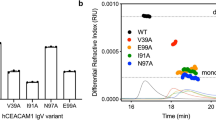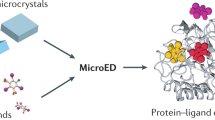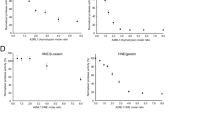Abstract
The X-ray crystal structure of recombinant human monocyte chemoattractant protein (MCP-1) has been solved in two crystal forms. One crystal form (P), refined to 1.85 Å resolution, contains a dimer in the asymmetric unit, while the other (I) contains a monomer and was refined at 2.4 Å. Although both crystal forms grow together in the same droplet, the respective quaternary structures of the protein differ dramatically. In addition, both X-ray structures differ to a similar extent from the solution structure of MCP-1. Such extent of variability of quaternary structures is unprecedented. In the crystal structures, the well-ordered N termini of MCP-1 form 310-helices. Comparison of the three MCP-1 structures revealed a direct correlation between the main-chain conformation of the first two cysteine residues and the quaternary arrangements. These data can be used to explain the structural basis for the assignment of residues responsible for biological activity.
This is a preview of subscription content, access via your institution
Access options
Subscribe to this journal
Receive 12 print issues and online access
$189.00 per year
only $15.75 per issue
Buy this article
- Purchase on Springer Link
- Instant access to full article PDF
Prices may be subject to local taxes which are calculated during checkout
Similar content being viewed by others
References
Miller, M.D. & Krangel, M.S. Biology and biochemistry of the chemokines: a family of chemotactic and inflammatory cytokines. Crit. Rev. Immunol. 12, 17–46 (1992).
Gurney, M.E. Chemokines take center stage in inflammatory ills. Science 272, 954–956 (1996).
Rollins, B.J. Monocyte chemoattractant protein 1: a potential regulator of monocyte recruitment in inflammatory disease. Molec. Med. Today 1, 98–204 (1996).
Seine, Y. et al. Expression of leukocyte chemotactic cytokines in myocardial tissue. Cytokine. 7, 301–304 (1995).
Schall, T.J. & Bacon, K.B. Chemokines, leukocyte trafficking, and inflammation. Curr. Opin. Immunol. 6, 865–873 (1994).
Kelner, G.S. et al. Lymphotactin: a cytokine that represents a new class of chemokine. Science 266, 1395–1399 (1994).
Wells, T.N.C., Proudfoot, A.E.I., Power, C.A. & Marsh, M. Chemokine receptors - the new frontier for AIDS research. Chemistry & Biology 3, 603–609 (1996).
Paolini, J.F., Willard, D., Consler, T., Luther, M. & Krangel, M.S. The chemokines IL-8, monocyte chemoattractant protein-1, and I-309 are monomers at physiologically relevant concentrations. J. Immunol. 153, 2704–2717 (1994).
Zhang, Y. & Rollins, B.J. A dominant negative inhibitor indicates that a monocyte chemoattractant protein 1 functions as a dimer. Mol. Cell. Biol. 15, 4851–4855 (1995).
Gong, J.H. & Clark-Lewis, I. Antagonists of monocyte chemoattractant protein 1 identified by modification of functionally critical NH2-terminal residues. J. Exp. Med. 181, 631–640 (1995).
Besemer, J., Schnitzel, W., Monschein, U. & Ryffel, B. Cross-linking of human neutrophil surface proteins to iodinated interleukin 8 or neutrophil activating peptide-2 results in at least four separable proteins. Cytokine. 5, 512–519 (1993).
Mayo, K.H. & Chen, M.J. Human platelet factor 4 monomer-dimer-tetramer equilibria investigated by 1H NMR spectroscopy. Biochemistry 28, 9469–9478 (1989).
Rajarathnam, K. et al. Neutrophil activation by monomeric interleukin-8. Science 264, 90–92 (1994).
Schnitzel, W., Monschein, U. & Besemer, J. Monomer-dimer equilibria of interleukin-8 and neutrophil-activating peptide 2. Evidence for IL-8 binding as a dimer and oligomer to IL-8 receptor B. J. Leukoc. Biol. 55, 763–770 (1994).
St. Charles, R., Walz, D.A. & Edwards, B.F. The three-dimensional structure of bovine platelet factor 4 at 3.0 Å resolution. J. Biol. Chem. 264, 2092–2099 (1989).
Zhang, X., Chen, L., Bancroft, D.P., Lai, C.K. & Maione, T.E. Crystal structure of recombinant human platelet factor 4. Biochemistry 33, 8361–8366 (1994).
Clore, G.M., Appella, E., Yamada, M., Matsushima, K. & Gronenborn, A.M. Three-dimensional structure of interleukin 8 in solution. Biochemistry 29, 1689–1696 (1990).
Baldwin, E.T. et al. Crystal structure of interleukin-8: symbiosis of NMR and crystallography. Proc. Natl. Acad. Sci. USA 88, 502–506 (1991).
Malkowski, M.G., Wu, J., Lazar, J.B., Johnson, P.M. & Edwards, B.F.P. The crystal structure of recombinant human neutrophil-activating peptide-2 (M6L) at 1.9 Å resolution. J. Biol. Chem. 270, 7077–7087 (1995).
Lodi, P.J. et al. High-resolution solution structure of the beta chemokine hMIP-1 beta by multidimensional NMR. Science 263, 1762–1767 (1994).
Fairbrother, W.J., Reilly, D., Colby, T.J., Hesselgesser, J. & Horuk, R. The solution structure of melanoma growth stimulating activity. J. Mol. Biol. 242, 252–270 (1994).
Chung, C.W., Cooke, R.M., Proudfoot, A.E. & Wells, T.N. The three-dimensional solution structure of RANTES. Biochemistry 34, 9307–9314 (1995).
Skelton, N.J., Aspiras, F., Ogez, J. & Schall, T.J. Proton NMR assignments and solution conformation of RANTES, a chemokine of the C-C type. Biochemistry 34, 5329–5342 (1995).
Handel, T.M. & Domaille, P.J. Heteronuclear (1H, 13C, 15N) NMR assignments and solution structure of the monocyte chemoattractant protein-1 (MCP-1) dimer. Biochemistry 35, 6569–6584 (1996).
Clore, G.M. & Gronenborn, A.M. Comparison of the solution nuclear magnetic resonance and crystal structures of interleukin-8. Possible implications for the mechanism of receptor binding. J. Mol. Biol. 217, 611–620 (1991).
Zhang, Y.J., Rutledge, B.J. & Rollins, B.J. Structure/activity analysis of human monocyte chemoattractant protein-1 (MCP-1) by mutagenesis. Identification of a mutated protein that inhibits MCP-1-mediated monocyte chemotaxis. J. Biol. Chem. 269, 15918–15924 (1994).
Weber, M., Uguccioni, M., Baggiolini, M., Clark-Lewis, I. & Dahinden, C.A. Deletion of the NH2-terminal residue converts monocyte chemotactic protein 1 from an activator of basophil mediator release to an eosinophil chemoattractant. J. Exp. Med 183, 681–685 (1996).
Beall, C.J., Mahajan, S., Kuhn, D.E. & Kolattukudy, P.E. Site-directed mutagenesis of monocyte chemoattractant protein-1 identifies two regions of the polypeptide essential for biological activity. Biochem. J. 313, 633–640 (1996).
Maclean, J., Isaacs, N.W. & Graham, G.J. Crystallographic studies of mutants of the chemokine macrophage inflammatory protein. International Union of Crystallography XVII Congress and General Assembly. C–222 (1996).
Beall, C.J., Mahajan, S. & Kolattukudy, P.E. Conversion of monocyte chemoattractant protein-1 into a neutrophile attractant by substitution of two amino acids. J. Biol. Chem. 267, 3455–3459 (1992).
Covell, D.G., Smythers, G.W., Gronenborn, A.M. & Clore, G.M. Analysis of hydrophobicity in the alpha and beta chemokine families and its relevance to dimerization. Protein Sci. 3, 2064–2072 (1994).
Wlodawer, A., Deisenhofer, J. & Huber, R. Comparison of two highly refined structures of bovine pancreatic trypsin inhibitor. J. Mol. Biol. 193, 145–156 (1987).
Faber, H.R. & Matthews, B.W. A mutant T4 lysozyme displays five different crystal conformations. Nature 348, 263–266 (1990).
Huang, D.B. et al. Comparison of crystal structures of two homologous proteins: structural origin of altered domain interactions in immunoglobulin light-chain dimers. Biochemistry 33, 14848–14857 (1994).
Murray, A.J., Lewis, S.J., Barclay, A.N. & Brady, R.L. One sequence, two folds: A metastable structure of CD2. Proc. Natl. Acad. Sci. USA 92, 7337–7341 (1995).
Otwinowski, Z. in An Oscillation Data Processing Suite for Macromolecular Crystallography (Yale University, New Haven, 1992).
CCP4:SERC Collaborative Computing Project No.4. (Warrington, UK, 1979).
Brünger, A. X-PLOR Version 3.1: A System for X-Ray Crystallography and NMR (Yale University Press, New Haven, 1992).
Jones, T.A. Interactive computer graphics: FRODO. Methods Enzymol. 115, 157–171 (1985).
Jones, T.A., Zou, J.-Y. & Cowan, S.W. Improved methods for building protein models in electron density maps and the location of errors in these methods. Acta Cryst. A 47, 110–119 (1991).
Brünger, A.T. The free R value: a novel statistical quantity for assessing the accuracy of crystal structures. Nature 355, 472–474 (1992).
Laskowski, R.A., MacArthur, M.W., Moss, D.S. & Thornton, J.M. PROCHECK: A program to check the stereochemical quality of protein structures. J. Appl. Crystallogr. 26, 283–291 (1993).
Hutchinson, E.G. & Thornton, J.M. PROMOTIF - A program to identify and analyze structural motifs in proteins. Protein Sci. 5, 212–220 (1996).
Satow, Y., Cohen, G.H., Padlan, E.A. & Davies, D.R. Phosphocholine binding immunoglobulin Fab McPC603: An X-ray diffraction study at 2.7 Å. J. Mol. Biol. 190, 593–604 (1986).
Kraulis, P.J. MOLSCRIPT: a program to produce both detailed and schematic plots of protein structures. J. Appl. Crystallogr. 24, 946–950 (1991).
Author information
Authors and Affiliations
Rights and permissions
About this article
Cite this article
Lubkowski, J., Bujacz, G., Boqué, L. et al. The structure of MCP-1 in two crystal forms provides a rare example of variable quaternary interactions. Nat Struct Mol Biol 4, 64–69 (1997). https://doi.org/10.1038/nsb0197-64
Received:
Accepted:
Issue Date:
DOI: https://doi.org/10.1038/nsb0197-64
This article is cited by
-
The marriage of chemokines and galectins as functional heterodimers
Cellular and Molecular Life Sciences (2021)
-
PCalign: a method to quantify physicochemical similarity of protein-protein interfaces
BMC Bioinformatics (2015)
-
Crystal structure of a mirror-image L-RNA aptamer (Spiegelmer) in complex with the natural L-protein target CCL2
Nature Communications (2015)
-
Soluble overexpression and purification of bioactive human CCL2 in E. coli by maltose-binding protein
Molecular Biology Reports (2015)
-
Molecular basis of lateral force spectroscopy nano-diagnostics: computational unbinding of autism related chemokine MCP-1 from IgG antibody
Journal of Molecular Modeling (2013)



